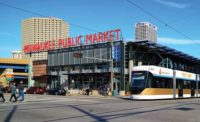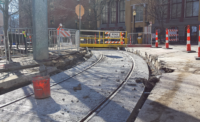M-Line (The Hop)
Milwaukee
Best Project
Owner: City of Milwaukee
General Contractor: Kiewit Infrastructure Corp.
Lead Design Firm: HNTB Corp.
Structural Engineer: HNTB Corp.
In the age of ride sharing, Milwaukee adopted the oldest ride sharing method of all—a streetcar.
The Hop is Milwaukee’s first embedded-track streetcar in the city in more than 50 years. The first phase of the system is the M-Line, which consists of a 2.1-mile route dotted by 18 stations that opened in November 2018. The $100-million M-Line runs from Lake Michigan to the Milwaukee Intermodal Station on the southwest side of town.
The project was approved by the Milwaukee Common Council in January 2015, and Omaha-based Kiewit Infrastructure won the bid to construct the system in August 2016. Mainline construction began in March 2017, nearly 59 years to the day after Milwaukee’s previous streetcar shut down.
The M-Line’s 16-month construction included $20 million in utility relocations and 26 blocks of newly constructed track alignment, or 3.7 track miles. The construction delivery method was construction manager/general contractor. CM/GC is commonly used for buildings, but Kiewit took the rare step of using it for the horizontal construction that a railway requires. The reason was to allow Kiewit flexibility with changes in the field and to develop a stronger collaboration between the city, HNTB and Kiewit.
The entire system was designed with innovative solutions in mind. The M-Line introduces intelligent transportation system (ITS) elements to both the city and the country. ITS utilizes GPS and wireless communication with transit active signals to provide efficient and safe operations. The Hop is the first system to use wireless switch technology via GPS in the U.S.
The streetcar includes overhead wires above the city streets, yet nearly half the system’s route (40%) is off-wire. Ashley Booth, HNTB Wisconsin office leader, says that the off-wire technology makes the M-Line one of only five passenger rail systems in the country to operate on lithium-ion batteries. This was done not only to help save on cost but to provide an improved environment.
The Hop’s funding is backed by Potawatomi Hotel and Casino, making it one of the only transit systems in the country to be built as a P3.
“People asked why would the Forest County Potawatomi Community do that? The streetcar doesn’t even go there,” Booth says. “But that speaks to their level of commitment to the community and the project.”
It’s a project that has fingerprints all over the community. The streetcar shelters along the route were constructed with steel beams and glass panels to provide a sleek architectural design different from the other forms of downtown transportation. The route’s OCS poles are designed to blend into the urban aesthetic, while the project team worked with local property owners in the historic district to create a design that complemented the historic features of Milwaukee.
Over its first 11 months the system had more than 45,000 trips carrying 740,000 riders over 90,000 miles. From 2017 to 2018, there was an overall increase of real estate value of $263 million within a quarter-mile of the M-Line. Along both the M-Line and the Hop’s planned extension (L-Line), there are 435 apartment units and more than 650 hotel rooms under construction or in development.
Back to "35 Best Projects Showcase Midwest Design, Construction Innovation"






Post a comment to this article
Report Abusive Comment